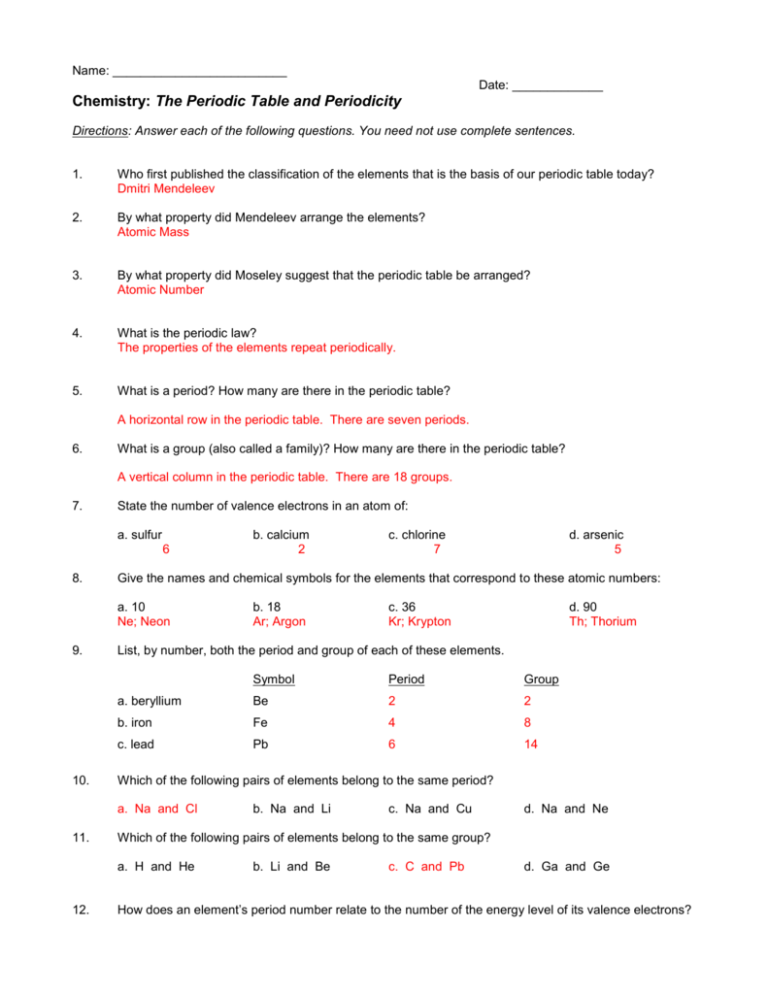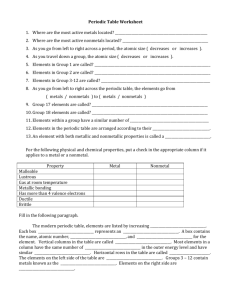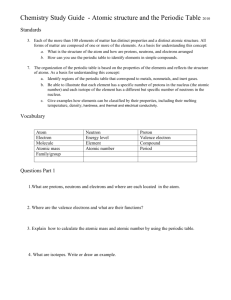Periodic+Table+Review+Questions 300 Key
advertisement

Name: _________________________ Date: _____________ Chemistry: The Periodic Table and Periodicity Directions: Answer each of the following questions. You need not use complete sentences. 1. Who first published the classification of the elements that is the basis of our periodic table today? Dmitri Mendeleev 2. By what property did Mendeleev arrange the elements? Atomic Mass 3. By what property did Moseley suggest that the periodic table be arranged? Atomic Number 4. What is the periodic law? The properties of the elements repeat periodically. 5. What is a period? How many are there in the periodic table? A horizontal row in the periodic table. There are seven periods. 6. What is a group (also called a family)? How many are there in the periodic table? A vertical column in the periodic table. There are 18 groups. 7. State the number of valence electrons in an atom of: a. sulfur 6 8. 10. b. 18 Ar; Argon c. 36 Kr; Krypton d. 90 Th; Thorium Symbol Period Group a. beryllium Be 2 2 b. iron Fe 4 8 c. lead Pb 6 14 Which of the following pairs of elements belong to the same period? b. Na and Li c. Na and Cu d. Na and Ne Which of the following pairs of elements belong to the same group? a. H and He 12. d. arsenic 5 List, by number, both the period and group of each of these elements. a. Na and Cl 11. c. chlorine 7 Give the names and chemical symbols for the elements that correspond to these atomic numbers: a. 10 Ne; Neon 9. b. calcium 2 b. Li and Be c. C and Pb d. Ga and Ge How does an element’s period number relate to the number of the energy level of its valence electrons? Period Number = Energy level of valence electrons 13. What are the transition elements? They are the D-block elements and are located in Groups 3 through 12. 14. Would you expect strontium to be, chemically, more similar to calcium or rubidium and WHY? It would be more similar to calcium because strontium and calcium have two valence electrons. The valence electrons determine the properties of an atom. 15. What is the heaviest noble gas? What is the heaviest alkaline earth metal? Radon; Radium 16. In going from top to bottom of any group, each element has ___1___ more occupied energy level(s) than the element above it. 17. What are the Group 1 elements called? Alkali Metals 18. What are the Group 2 elements called? Alkaline Earth Metals 19. What are the Group 17 elements called? Halogens 20. What are the Group 18 elements called? Noble Gases 21a. What is the name of the elements is Groups 3 to 12? (This questions should have said “Groups 3 to 12”) Transistion metals 21. List the three lightest members of the noble gases. He, Ne, Ar 22. List all of the alkali metals. Li, Na, K, Rb, Cs, Fr 23. Which alkali metal belongs to the sixth period? Cs 24. Which halogen belongs to the fourth period? 25. What element is in the fifth period and the eleventh group? Ag 26. Why do all the members of a group have similar properties? They have the same number of valence electrons. 27. What do we mean by the “atomic radius?” Br The size of a neutral (not ionic) atom. 28. Within a group, what happens to the atomic radius as you go down the column? Increases 29. Explain your answer to Question 28: Why does the atomic radius change? The addition of one energy level as you move down the group. 30. Within a period, what happens to the atomic radius as the atomic number increases? Decreases 31. Explain your answer to Question 30: Why does the atomic radius change? No additional energy levels are added; however, more protons are added (increased nuclear charge) to the nucleus increasing the pull on the electrons. 32. How are neutral atoms converted into cations? How are neutral atoms converted into anions? Loss of electroncs 33. Gain of electrons Metals usually form what type of ions? Nonmetals usually form what type of ions? Cations (positive) Anions (negative) 34. What is ionization energy? The energy required to remove an electron from an atom. 35. What is the general trend of ionization energy as you go from left to right across the periodic table? Increases due to increased nuclear charge (protons hold onto the electrons tightly) 36. What is the general trend of ionization energy as you go down a group on the periodic table? Decreases due to the larger size of the atom and electrons shielding; both reduce the pull of the nucleus on the electrons. 37. Which of these elements has the highest first ionization energy: Sn, As, or S? S 38. Where, generally, are the metals located on the periodic table? To the left of the stairstep 39. Where, generally, are the nonmetals located on the periodic table? To the right of the stairstep 40. A. B. C. List some properties of metals. Lose electrons to form positive ions (cations); good conductors of heat and electricity; malleable (able to be hammered into sheets); ductile (can be pulled into wires); have luster (shiny); solid at room temperature except for mercury List some properties of nonmetals. Gain electrons to for negative ions (anions); poor conductors of heat and electricity; brittle (not malleable or ductile); dull (not shiny); some are solid, some are liquid and some are gas at room temperature. What kinds of properties do metalloids have? Properties of both metals and nonmetals. 41. What is electronegativity? A measure of the ability of an atom to ATTRACT electrons to itself. 42. List the following atoms in order of increasing electronegativity: O, Al, Ca Ca<Al<O 43. List the following atoms in order of decreasing electronegativity: Cl, K, Cu Cl>Cu>K 44. What is the general trend of electronegativity as you go down the periodic table? 45. Decreases due added energy levels and electron shielding which reduces the pull of the nucleus on the electrons. What is the general trend of electronegativity as you go left to right across the periodic table? Increases due to the additional nuclear charge (protons) while NOT adding any energy levels.






